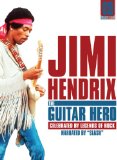This documentary is a mainly a sea of praise for the late guitar legend, as it promises to not focus on “drudging up scandal and outworn hypothesis about his lifestyle and ultimate death.” historical footage tells the biographical portions while high-profile interviws with the likes of Lemmy Kilmister (Motorhead), Eric Clapton, Mick Taylor (Rolling Stones), Stephen Stills (Crosby, Stills & Nash) and moany more, plus narration by super-fan Slash (Guns N Roses).
As the early history of Hendrix is told, namely when he was brought to England, where he made a name for himself, a baffling series of celebrities’ names are dropped as noted admirers. For example, one London club concert featured in its first few rows, all of the Beatles, most of the Rolling Stones, Cream, Steve Winwood, and The Who…all there to see Hendrix redefine the sound of the electric guitar. The filmmakers use this explosion of legendary names to gain interest in the audience, which is a fine tactic. They save biographical details for the second act but never let up on the limitless line of admirers, celebrity or otherwise. As a matter of fact, the amount of praise borders on being redundant for it seems relentless, but such a subject truly deserves every word the interviewees have to say.
The fact that Hendrix was a black man made him a novelty in the London music scene as it was simply rare to see for the general populace, and they embraced him immediately. In the US, Hendrix was an in-demand touring musician but could not catch a break for himself for the nation was still plagued by segregation. By moving to England, he was immediately amongst friends and able to be appreciated for the stellar talent that he was.
This is a well assembled tribute and fascinating profile for any curious music fan (and the like fifteen people out there who have NOT heard of Hendrix).
Oh, and a no-prize award to the lame, pandering “Guitar Hero” reference in the title. Shame, shame.
Video
Widescreen 1.78:1. The found footage and still pictures look decent but the interview footage are all varying degrees of fuzzy. I can forgive this in the amateur, or badly aged footage that is used, but there is no excuse for the interviews to look as bad as they do.
Audio
Dolby Digital Stereo. Hendrix was such a sonic force, its a shame this couldn’t be offered in Surround. I would do nothing but sing this film’s praises if I could be fully immersed in a rendition of “Hey Joe”..but alas, I am left wanting. Aside from my pining, the quality is good. The worst I can say is having to understand the burnt out mumblings from the likes of Ginger Baker.
Special Features
Just as Special Features should be, expanding on what you’ve already seen in the film. All I wish for was more performance footage of Hendrix.
Henry Diltz’s 8mm silent footage of The Monkees’ 1967 Tour: Only a few short minutes long, this is footage used during parts of the film. The title explains more than I ever could. I suppose it’d be interesting to some. Hendrix appears in none of it as far as I can decipher.
Full performance of “Hey Joe” by The Experience at the Marquee in London: Now here is a real treat. Hendrix is in splendid form as there is there is just SO much going on with his playing of what seems to be a simple blues tune on the surface; but only because he makes it seem so effortless. Oh, and as a bonus, he does play the solo with his teeth.
Extended interviews: A wide selection of additional stories and opinions from Slash, Mick Taylor, Micky Dolenz, Leon Hendrix, Joey Covington, Stephen Stills, Dave Mason and (my personal favourite of the lot) Lemmy Kilmister, who was a roadie for Hendrix for eight months. Just as interesting as what was included in the film, its just obvious there simply was not enough room for it all.
Photographs: Two galleries of very fine pictures, most of which used in the film, and some being provided by Henry Diltz.
20-page booklet: Includes more details on his life and nice pictures.
Final Thoughts
This film rides on a sea of praise from those who worked with him, family, friends, and varying types of devoted fans (everything from biographers to musicians who were inspired by his playing). It would have been nice to see a little more footage of Jimi speaking for himself, but since this was less biographical, and more a profile of his enormous talents and effects on the music world, I can see how it was more significant for others to speak about him.





